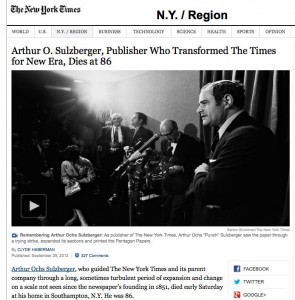With the recent passing of Arthur Ochs Sulzberger, the former publisher of The New York Times (NYT) and Chairman and CEO of The New York Times Co., much is being said about the transformative years of expansion and change under his 34-year tenure. His obituary talks about his reign from “the era of the hot lead and Linotype machine to the birth of the digital world” and how, under his leadership, the company became a diversified media operation that included newspapers, magazines, television/radio stations and online ventures. Of particular note was his apparent willingness to invest, in expanding the number of sections in the newspaper as well as into other areas, when most others were not so willing.
Richard L. Gelb, a long-time member of the Times board, said in 1997, “Adolph Ochs is remembered as the one who founded this great enterprise, and Arthur Ochs Sulzberger will be remembered as the one who secured it, renewed it and lifted it to ever-higher levels of achievement.” It is my experience that this visionary “way of thinking” about the responsibilities of leadership may be a distinguishing feature of many family-influenced companies.
Over my career, I have spent considerable time looking into the entrepreneurial dimensions of such companies — even co-authoring a journal article that ruffled more than a few feathers among traditionalists in this field. The article explored how an enterprising family would move beyond an exclusive focus on the sustainability of any given set of operating assets to create wealth for future generations, or what we called “transgenerational weath creation”.
Say a family is in the shoemaking business. If they are enterprising, they will keep that operation running (if it’s sustainable) while exploring new opportunities. By contrast, other families will focus only on the shoemaking business, to the detriment of future ventures. Not so an enterprising family who views current assets as a platform to stand on while constantly seeking new sources of wealth creation in perpetuity.
Back to Sulzberger: he made sure that the NYT operating assets were used, in part, to maintain a vibrant and independent journalistic voice by not hunkering down on managing newspapers and newspapers alone.
Do typical CEOs have a similar stewardship view when leading their organisations? Some CEOs, sure. But in far too many cases a larger purpose — one that extends beyond short-term earnings performance and stock market valuations– is seriously lacking. Shake hands with a CEO who is 100% about meeting monthly or quarterly goals while posting hefty dividends, and you will probably be in the presence of someone who never will understand or appreciate all the praise of Arthur Ochs Sulzberger on his passing. The former is myopic; the latter was a leader.
